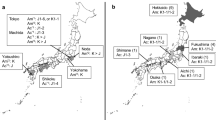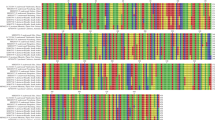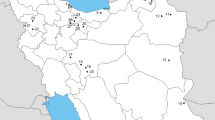Abstract
The ectoparasite Varroa (Acari: Varroidae) is considered to be the main pest of honey bees (Apis mellifera L.) in Nicaragua. The aim of this study was to determine morphotypes and mitochondrial haplotypes of the Varroa mites, related to infestation levels in A. mellifera hives in Nicaragua in a cross-sectional study (2013–2016). Samples were taken from 34 sentinel apiaries in five geographical zones; from 713 Varroa females collected during the study, 153 were selected for measurement of various morphometric characters for further classification into morphotypes. The mitochondrial haplotype was assigned to one of the two (Korean or Japanese), using the restriction by SacI of the PCR product of a fragment of the gene CO-I. Morphometric measurement and sequencing revealed the affiliation to the species Varroa destructor with a mean (± SD) body width of 1699.1 ± 60.2 µm and a body length of 1161.1 ± 34.9 µm. Body characters were significantly different among the 34 apiaries. Varroa destructor samples were classified into four morphotypes, with no significant differences in the geographical zones. As GAGCTC SacI enzyme cleavage sequences were not observed, all PCR products were identified as V. destructor Korean haplotype. The CO-I gene nucleotide sequences from two samples V. destructor showed both 100% similarity with the Korean haplotype and 99.8% similarity to the Japanese haplotype. Although the V. destructor mite was identified as a Korean haplotype, host-parasite association in 2 decades has led into a balance without entering into severe losses in the Nicaraguan apiculture.




Similar content being viewed by others
Data availability
The datasets generated during and/or analyzed during the current study are available from the corresponding author on reasonable request.
References
Anderson DL (2000) Variation in the parasitic bee mite Varroa jacobsoni Oud. Apidologie 31:281–292. https://doi.org/10.1051/apido:2000122
Anderson DL, Fuchs S (1998) Two genetically distinct populations of Varroa jacobsoni with contrasting reproductive abilities on Apis mellifera. J Apic Res 37:69–78. https://doi.org/10.1080/00218839.1998.11100957
Anderson DL, Trueman JW (2000) Varroa jacobsoni (Acari: Varroidae) is more than one species. Exp Appl Acarol 24:165–189. https://doi.org/10.1023/a:1006456720416
Calderón RA, van Veen JW, Sommeijer MJ, Sanchez LA (2010) Reproductive biology of Varroa destructor in Africanized honey bees (Apis mellifera). Exp Appl Acarol 50:281–297. https://doi.org/10.1007/s10493-009-9325-4
Carneiro FE, Torres RR, Strapazzon R et al (2007) Changes in the reproductive ability of the mite Varroa destructor (Anderson e Trueman) in africanized honey bees (Apis mellifera L.) (Hymenoptera: Apidae) colonies in southern Brazil. Neotrop Entomol 36:949–952. https://doi.org/10.1590/S1519-566X2007000600018
Chen YP, Siede R (2007) Honey bee viruses. Adv Virus Res 70:33–80. https://doi.org/10.1016/S0065-3527(07)70002-7
DeJong D, Soares AEE (1997) An isolated population of Italian bees that has survived Varroa jacobsoni infestation without treatment for over 12 years. Am Bee J 137:742–745
Delaplane KS, Hood WM (1999) Economic threshold for Varroa jacobsoni Oud. in the southeastern USA. Apidologie 30:383–395. https://doi.org/10.1051/apido:19990504
Delfinado-Baker M, Houck MA (1989) Geographic variation in Varroa jacobsoni (Acari, Varroidae): application of multivariate morphometric techniques. Apidologie 20:345–358. https://doi.org/10.1051/apido:19890407
Fries I, Hansen H, Imdorf A, Rosenkranz P (2003) Swarming in honey bees (Apis mellifera) and Varroa destructor population development in Sweden. Apidologie 34:389–397. https://doi.org/10.1051/apido:2003032
Garrido C, Rosenkranz P, Paxton RJ, Gonçalves LS (2003) Temporal changes in Varroa destructor fertility and haplotype in Brazil. Apidologie 34:535–541. https://doi.org/10.1051/apido:2003041
Giacobino A, Pacini A, Molineri A et al (2018) Potential associations between the mite Varroa destructor and other stressors in honeybee colonies (Apis mellifera L.) in temperate and subtropical climate from Argentina. Prev Vet Med 159:143–152. https://doi.org/10.1016/j.prevetmed.2018.09.011
Harbo JR, Bolten AB, Rinderer TE, Collins AM (1981) Development periods for eggs of Africanized and European honeybees. J Apic Res 20:156–159. https://doi.org/10.1080/00218839.1981.11100490
Harris JW (2008) Effect of brood type on Varroa-Sensitive hygiene by worker honey bees (hymenoptera: apidae). Ann Entomol Soc Am 101:1137–1144. https://doi.org/10.1603/0013-8746-101.6.1137
INETER (2020) Instituto Nacional de Metereología. In: Dirección General de Meteorología. https://www.ineter.gob.ni/met.html
Jong D, Roma DDA, Gonçalves LS (1982) A comparative analysis of shaking solutions for the detection of Varroa jacobsoni on adult honeybees. Apidologie 13:297–306. https://doi.org/10.1051/apido:19820308
Le Conte Y, Ellis M, Ritter W (2010) Varroa mites and honey bee health: can Varroa explain part of the colony losses? Apidologie 41:353–363. https://doi.org/10.1051/apido/2010017
Le Conte Y, Navajas M (2008) Climate change: impact on honey bee populations and diseases. Rev Sci Tech Int Off Epizoot 27(485–497):499–510
Li W, Wang C, Huang ZY et al (2019) Reproduction of distinct Varroa destructor genotypes on honey bee worker brood. Insects 10:372. https://doi.org/10.3390/insects10110372
Lobo JA (1995) Morphometric isozymic and mitochondrial variability of Africanized honeybees in Costa Rica. Heredity 75:133–141. https://doi.org/10.1038/hdy.1995.116
Lobo Segura JA (2000) Highly polymorphic DNA markers in an Africanized honey bee population in Costa Rica. Genet Mol Biol 23:317–322. https://doi.org/10.1590/S1415-47572000000200013
Locke B (2016) Natural Varroa mite-surviving Apis mellifera honeybee populations. Apidologie 47:467–482. https://doi.org/10.1007/s13592-015-0412-8
Loeza-Concha H, Domínguez-Rebolledo Á, Escalera-Valente F et al (2018) Morphometric identification of Varroa destructor and its plasticity by the exposure to thymol. Abanico Vet 8:98–107
Maggi M, Medici S, Quintana S et al (2012a) Genetic structure of Varroa destructor populations infesting Apis mellifera colonies in Argentina. Exp Appl Acarol 56:309–318. https://doi.org/10.1007/s10493-012-9526-0
Maggi M, Peralta L, Ruffinengo S et al (2012b) Body size variability of Varroa destructor and its role in acaricide tolerance. Parasitol Res 110:2333–2340. https://doi.org/10.1007/s00436-011-2768-7
Maggi MD, Ruffinengo SR, Mendoza Y et al (2011) Susceptibility of Varroa destructor (Acari: Varroidae) to synthetic acaricides in Uruguay: Varroa mites’ potential to develop acaricide resistance. Parasitol Res 108:815–821. https://doi.org/10.1007/s00436-010-2122-5
Maggi MD, Sardella NH, Ruffinengo SR, Eguaras MJ (2009) Morphotypes of Varroa destructor collected in Apis mellifera colonies from different geographic locations of Argentina. Parasitol Res 105:1629. https://doi.org/10.1007/s00436-009-1605-8
Martin SJ, Medina LM (2004) Africanized honeybees have unique tolerance to Varroa mites. Trends Parasitol 20:112–114. https://doi.org/10.1016/j.pt.2004.01.001
Martinez P, Invernizzi C, Mendoza Y et al (2017) Morphometric correlation between Apis mellifera morphotypes (Hymenoptera) and Varroa destructor (Acari) from Uruguay. J Apic Res. https://doi.org/10.1080/00218839.2017.1287998
Morgulis A, Coulouris G, Raytselis Y et al (2008) Database indexing for production MegaBLAST searches. Bioinformatics 24:1757–1764. https://doi.org/10.1093/bioinformatics/btn322
Muntaabski I, Russo RM, Liendo MC et al (2020) Genetic variation and heteroplasmy of Varroa destructor inferred from ND4 mtDNA sequences. Parasitol Res 119:411–421. https://doi.org/10.1007/s00436-019-06591-5
Navajas M, Migeon A, Estrada-Peña A, et al (2010) Mites and ticks (Acari) Chapter 7.4
OIE (1996) HANDISTATUS II Annual animal disease status. http://web.oie.int/hs2/sit_mald_cont.asp?c_mald=134&c_cont=2&annee=2000. Accessed 10 Mar 2020
OIE (2000) HANDISTATUS II Annual animal disease status. http://web.oie.int/hs2/sit_mald_cont.asp?c_mald=134&c_cont=2&annee=1996. Accessed 10 Jan 2020
Pinto F, Puker A, Message D, Barreto L (2011) Varroa destructor in Juquitiba, Vale do Ribeira, Southeastern Brazil: seasonal effects on the infestation rate of ectoparasitic mites on honeybees. Sociobiology 57:511–518
Pinto FA, Puker A, Message D et al (2015) Infestation rate of the mite Varroa destructor in commercial apiaries of the Vale do Paraíba and Serra da Mantiqueira, southeastern Brazil. Arq Bras Med Veterinária E Zootec 67:631–635. https://doi.org/10.1590/1678-7264
Rath W (1999) Co-adaptation of Apis cerana Fabr. and Varroa jacobsoni Oud. Apidologie 30:97–110. https://doi.org/10.1051/apido:19990202
Rinderer TE, Hellmich RL, Danka RG, Collins AM (1985) Male reproductive parasitism: a factor in the africanization of European honey-bee populations. Science 228:1119–1121. https://doi.org/10.1126/science.228.4703.1119
Rosenkranz P (1999) Honey bee (Apis mellifera L.) tolerance to Varroa jacobsoni Oud. in South America. Apidologie 30:159–172
Rosenkranz P, Aumeier P, Ziegelmann B (2010) Biology and control of Varroa destructor. J Invertebr Pathol 103(Suppl 1):S96-119. https://doi.org/10.1016/j.jip.2009.07.016
Rosenkranz P, Engels W (1994) Genetic and environmental influences on the duration of preimaginal worker development in eastern (Apis cerana) and western (Apis mellifera) honey bees in relation to varroatosis. Rev Bras Genet 17:383–391
Rothenbuhler WC (1964) Behaviour genetics of nest cleaning in honey bees. I. Responses of four inbred lines to disease-killed brood. Anim Behav 12:578–583. https://doi.org/10.1016/0003-3472(64)90082-X
Saitou N, Nei M (1987) The neighbor-joining method: a new method for reconstructing phylogenetic trees. Mol Biol Evol 4:406–425. https://doi.org/10.1093/oxfordjournals.molbev.a040454
Sandoval González E (2020) Situación zoosanitaria de los niveles de infestación de varroosis en Apis mellifera en Nicaragua 2009–2015. Universidad Nacional Autónoma de Nicaragua, Leon
Solignac M, Cornuet J-M, Vautrin D et al (2005) The invasive Korea and Japan types of Varroa destructor, ectoparasitic mites of the Western honeybee (Apis mellifera), are two partly isolated clones. Proc Biol Sci 272:411–419. https://doi.org/10.1098/rspb.2004.2853
Swezey SL (1986) Africanized honey bees arrive in Nicaragua. J Apic Res 126:283–287
Tamura K, Stecher G, Peterson D et al (2013) MEGA6: molecular evolutionary genetics analysis version 6.0. Mol Biol Evol 30:2725–2729. https://doi.org/10.1093/molbev/mst197
Vandame R, Palacio MA (2010) Preserved honey bee health in Latin America: a fragile equilibrium due to low-intensity agriculture and beekeeping? Apidologie 41:243–255. https://doi.org/10.1051/apido/2010025
Wilde J, Fuchs S, Bratkowski J, Siuda M (2005) Distribution of Varroa destructor between swarms and colonies. J Apic Res 44:190–194. https://doi.org/10.1080/00218839.2005.11101177
Acknowledgements
The authors thank the beekeepers for their collaboration in the field work and for the permission to investigate on their beehives and Nicola J. Singh MAAT for her review and comments on the English language.
Author information
Authors and Affiliations
Corresponding author
Ethics declarations
Conflicts of interest
The authors declare that they have no conflict of interest.
Ethical approval
The study has been performed in accordance with the standard procedures for the surveillance of emerging diseases in apiaries established by Organismo Internacional Regional de Sanidad Agropecuaria (OIRSA), and was previously approved by the Research Ethics Committee (ECAV, UNAN-León).
Additional information
Publisher's Note
Springer Nature remains neutral with regard to jurisdictional claims in published maps and institutional affiliations.
Rights and permissions
About this article
Cite this article
Düttmann, C., Flores, B., Sheleby-Elías, J. et al. Morphotype and haplotype identification of Varroa destructor (Acari: Varroidae), and its importance for apiculture in Nicaragua. Exp Appl Acarol 83, 527–544 (2021). https://doi.org/10.1007/s10493-021-00603-9
Received:
Accepted:
Published:
Issue Date:
DOI: https://doi.org/10.1007/s10493-021-00603-9




